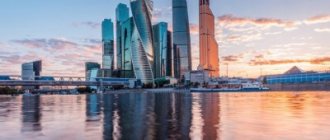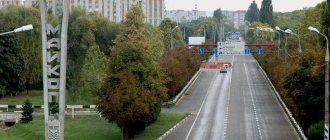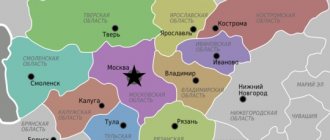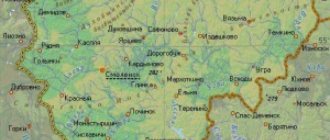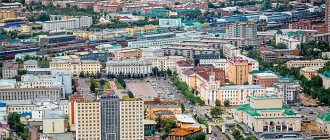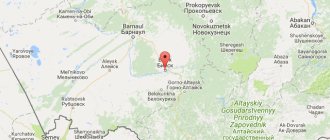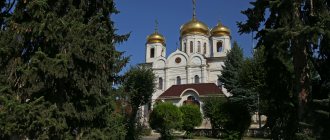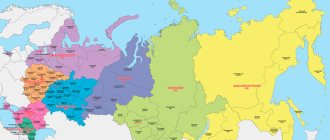Moscow city (Russia)
Moscow is the capital of Russia and the largest city in the country. This is a huge metropolis, which is the historical, political and spiritual heart of the Russian Federation. Moscow is the largest capital of Europe, filled with attractions, historical and cultural monuments, and world-class museums. This is a city of incredible dynamics and size that cannot be grasped in one trip.
Moscow is a charming modern city with a huge number of attractions and interesting places: from ancient fortresses and grandiose cathedrals to beautiful parks and futuristic skyscrapers. The capital of Russia has existed for about nine centuries. On its streets you can find ancient sacred monuments and palaces, which coexist with monumental buildings of Soviet architecture and ultra-modern structures. But this is not the only thing Moscow is famous for. The capital has a colossal number of theaters, museums, galleries, as well as excellent restaurants, cozy cafes and fashionable clubs. Therefore, Moscow can keep any tourist busy for a long time.
Brief description of Moscow
Moscow is a huge, amazing city. A few days here and you will get used to the noise and Muscovites always in a hurry. Over the past 15 years, Moscow has radically changed its appearance, becoming more and more like European capitals, where tourists come to get impressions and spend money. But Moscow has not lost its eternal charm, which attracts more and more tourists here. The traditions of Moscow are unshakable; even in the appearance of the city, features inherent to it from time immemorial are preserved, for example, the radial-ring layout that developed at the end of the 16th century, which is also determined by the special urban landscape: after all, Moscow is a city on seven hills.
The beauty of the Kremlin
From the wide highway you find yourself in a quiet lane, unchanged since the 19th century. Moscow, the capital of Russia, home to more than 12 million people, is the most controversial city in our vast country. Ancient beauty here coexists with bad taste, the sentimental soul of Muscovites is combined with a cynical modern mind. For hundreds of years, Moscow has been considered the center of Russian national culture.
Moscow in December
When visiting the capital, you will be able to see the Kremlin, the Novodevichy Convent, the Church of the Intercession in Fili, Moscow State University, the Arc de Triomphe, and the Victory Memorial Complex on Poklonnaya Hill. The last decades have become a kind of Renaissance for Moscow. The Cathedral of Christ the Savior on Kropotkinskaya Embankment was restored - it became the main cathedral of the city and the whole country, the Resurrection Gate of the Kremlin with the chapel of the Iverskaya Mother of God and the Church of the Icon of the Kazan Mother of God on Red Square were rebuilt. By order of the Moscow government, many monuments are being restored and public places are being improved: parks, boulevards.
The city has turned its face to the residents and guests of the capital - pedestrian zones are being organized, new hotels, cafes and restaurants are opening. Moscow regularly hosts major festivals, Olympics, sports competitions and various international competitions. You should definitely visit the famous capital museums and exhibition halls of the capital: the Pushkin Museum, the Tretyakov Gallery, the House of Artists. Every resident of Russia needs to visit the capital at least once in their life, to get acquainted with the centuries-old history of the great city.
Modern Moscow
Geography and climate
Moscow is located in the center of the European part of Russia between the Oka and Volga rivers on the banks of the river of the same name. The capital of Russia is located on the hilly plain of the East European Platform. The average height above sea level is 186 m. The highest point in Moscow is the Teplostanskaya Upland (255 m).
Moscow River
The city is located on the banks of the Moscow River, which is its main waterway. Within the capital, the following tributaries flow into the Moscow River: Skhodnya, Presnya, Neglinnaya, Yauza, Setun, Kotlovka, Gorodnya and other tributaries. There are also several hundred other bodies of water within the borders of the Russian capital.
Moscow has a temperate continental climate with clearly defined seasons. Summer here is usually relatively warm. Winters are quite cool with frequent thaws. Autumn in Moscow is cool and rainy. Spring is characterized by changeable weather, when warm days alternate with fairly cold ones.
Winter in Moscow
Interestingly, Moscow is one of the greenest cities in Europe. Landscaping makes up more than half of its territory. The capital of Russia has several hundred parks and forests. The largest of them are: Losiny Ostrov National Park, Izmailovsky Park, Timiryazevsky Park, Moskvoretsky Park, Filevsky Park, Tsaritsyno, Kolomenskoye.
Official statistics
According to official data, the population of Moscow is 12,678,079 people
. These are estimated data from Rosstat as of January 1, 2022, which noted that in the first six months the population grew by 20.5 thousand people.
By the way, many believe that the growth of Moscow’s population is solely due to migration, internal and external. But official statistics show a slightly different picture. So, for the first 2 months of 2022:
- 24,587 people arrived from other regions
, 26,221 people left. The increase due to internal migration is negative, minus 1634 people; - 2,205 foreigners
, 3,354 people left. The increase due to external migration is also negative, minus 1,149 people.
Of course, Rosstat data, even if they are based on information from the Migration Department of the Ministry of Internal Affairs, may not be accurate enough, and that small minus is rather a statistical error.
As can be seen from the data of the Moscow City Statistics Service, approximately 3/4 of the total population growth in Moscow are visitors from other regions. But there is also natural population growth, because the birth rate in the capital is higher than the death rate:
By the way, birth rate statistics confirm the fact that Moscow lives by completely different laws than the rest of Russia. At the beginning of 2020, the birth rate exceeded the death rate in only 3 regions - Moscow, Magadan region and Karachay-Cherkessia.
But 3 regions cannot take over all the statistics, and Russia continues to die out - the country has been recording a natural population decline for several years in a row. But in the first half of 2020, the numbers will definitely be adjusted – the coronavirus pandemic has changed everything.
Nevertheless, in Moscow the population is fairly evenly distributed according to the age structure:
It can be seen that the working-age population still accounts for a larger share than pensioners. By the way, thanks to more favorable living conditions in Moscow, people often “postpone” aging
–
continue to work
and lead an active life, even after retirement.
Moscow is large and consists of 125 districts and 21 settlements, which are united into administrative districts. The population of the districts is also uneven:
As you can see, the least population accounts for most of the area
city - New Moscow. But now these areas are being actively developed and attracting new residents.
Often you can find housing prices there at the level of the Moscow region, although administratively it is already Moscow, and residents are entitled to all the corresponding privileges.
Administrative divisions of Moscow
Administrative division of Moscow
Moscow is divided into 12 administrative districts. The last three are located outside the Moscow Ring Road.
- 1 - Central Administrative District of Moscow (CAO). Includes the following districts: Arbat, Basmanny, Zamoskvorechye, Krasnoselsky, Meshchansky, Presnensky, Tagansky, Tverskoy district, Khamovniki, Yakimanka.
- 2 - Northern Administrative District of Moscow (NAO). Districts: Airport, Begovoy, Beskudnikovsky district, Voykovsky district, Eastern Degunino, Golovinsky district, Dmitrovsky district, Western Degunino, Koptevo, Levoberezhny, Molzhaninovsky district, Savyolovsky district, Sokol, Timiryazevsky district, Khovrino, Khoroshevsky district.
- 3 - North-Eastern Administrative District of Moscow (NEAD). Districts: Alekseevsky district, Altufevsky district, Babushkinsky district, Bibirevo, Butyrsky district, Lianozovo, Losinoostrovsky district, Marfino, Maryina Roshcha, Ostankino district, Otradnoye, Rostokino, Sviblovo, Severny, Northern Medvedkovo, South Medvedkovo, Yaroslavsky district.
- 4 - Eastern Administrative District of Moscow (VAO). Districts: Bogorodskoye, Veshnyaki, Vostochny, Eastern Izmailovo, Golyanovo, Ivanovskoye, Izmailovo, Kosino-Ukhtomsky, Metrogorodok, Novogireevo, Novokosino, Perovo, Preobrazhenskoye, Northern Izmailovo, Sokolinaya Gora, Sokolniki.
- 5 - South-Eastern Administrative District of Moscow (SEAD). Districts: Vykhino-Zhulebino, Kapotnya, Kuzminki, Lefortovo, Lyublino, Maryino, Nekrasovka, Nizhny Novgorod district, Pechatniki, Ryazan district, Tekstilshchiki, Yuzhnoportovy district.
- 6 - Southern Administrative District of Moscow (South Administrative District). Districts: Biryulyovo Eastern, Biryulyovo Western, Brateevo, Danilovsky district, Donskoy district, Zyablikovo, Moskvorechye-Saburovo, Nagatino-Sadovniki, Nagatinsky Zaton, Nagorny district, Orekhovo-Borisovo Northern, Orekhovo-Borisovo Southern, Tsaritsyno, Chertanovo Northern, Chertanovo Central, Chertanovo South.
- 7 - South-Western Administrative District of Moscow (SWAD). Districts: Academichesky district, Gagarinsky district, Zyuzino, Konkovo, Kotlovka, Lomonosovsky district, Obruchevsky district, Northern Butovo, Teply Stan, Cheryomushki, Yuzhnoye Butovo, Yasenevo.
- 8 - Western Administrative District of Moscow (ZAO). Districts: Vnukovo, Dorogomilovo, Krylatskoye, Kuntsevo, Mozhaisky district, Novo-Peredelkino, Ochakovo-Matveevskoye, Vernadskogo Avenue, Ramenki, Solntsevo, Troparevo-Nikulino, Filevsky Park, Fili-Davydkovo.
- 9 - North-Western Administrative District of Moscow (NWAO). Districts: Kurkino, Mitino, Pokrovskoye-Streshnevo, Northern Tushino, Strogino, Khoroshevo-Mnevniki, Shchukino, Southern Tushino.
- 10 - Zelenograd administrative district of Moscow (ZelAO).
- 11 - Troitsky administrative district of Moscow.
- 12 - Novomoskovsky administrative district of Moscow.
Communications and Wi-Fi
Communications and the Internet in the capital are at a high level. Here people cannot imagine their life without high-speed Internet, so almost all cafes, restaurants and even parks have access points. A special pleasure is the Internet in the metro, which provides quick registration and instant access to the network (available only in carriages).
Communication exists both mobile and landline. For tourists, there are payphones throughout the city, the services of which can be paid with coins or bank cards. You can top up your mobile account in every store or through payment terminals.
Story
The exact age and date of foundation of Moscow are unknown. At the end of the first millennium BC, the Slavic tribes of the Vyatichi and Krivichi settled here. Archaeological finds indicate that a settlement on the site of the modern city already existed in the 11th century. The first mention of Moscow dates back to 1147, when Prince Yuri Dolgoruky received his allies here, led by the Novgorod prince Svyatoslav Olgovich. A decade later, the settlement was surrounded by wooden fortifications. In the 12th century, Moscow was referred to as Kuchkov. In the 13th century, during the Tatar-Mongol invasion, the town was plundered and burned.
In the 13th century, Moscow became the capital of the principality of the same name. During this period, the city grew and developed rapidly. In the 14th century, several other principalities were annexed to the Moscow Principality. The rise of Moscow as the center of Rus' is taking place. In the 15th century, during the reign of Ivan Kalita, the first stone buildings appeared in the future capital.
Streets of Moscow
Moscow became the capital of the Russian state under Ivan III Vasilyevich at the end of the 15th century. After the death of Ivan the Terrible, the city was first occupied by the troops of False Dmitry I, then besieged by the troops of False Dmitry II and then captured by the Poles. Moscow was liberated in 1612 by a militia led by Minin and Pozharsky.
In the 17th century, Moscow expanded even more. The Kremlin is acquiring modern features. In 1712, under Peter I, Moscow lost its capital status. St. Petersburg becomes the capital of Russia. At the same time, Moscow remains the place of coronation of Russian emperors and one of the most important cities of the Russian state. In 1755, Moscow University was founded here.
Modern panorama of Moscow
In 1812, during the Patriotic War, Moscow was captured by Napoleon's troops. During the siege, the city was set on fire. The fire destroyed about 80% of the buildings. The process of rebuilding the city took about 30 years. In the second half of the 19th century, the Moscow-St. Petersburg railway was opened, and at the end of the same century the first tram lines were opened.
In 1905, revolutionary unrest occurred in Moscow. In 1917, the Provisional Government was located here. Moscow regained its capital status in 1918, when the Bolshevik government moved here. In the early Soviet period, large-scale construction was underway in Moscow, which significantly damaged the historical buildings.
In the winter of 1941/42, the first major victory of the Soviet army over the troops of Nazi Germany was won in the battle of Moscow. After the war, the city was again built on a large scale. At this time, the famous “Stalinist high-rise buildings” and standard panel houses were erected. The last significant architectural changes and large-scale construction date back to the 2000s. During this period, the construction of shopping, office and business centers, luxury housing and modern transport infrastructure began.
Changes
The size of the city of Moscow has been constantly growing since its founding. But this increase took place not only as a result of the mechanical expansion of urban development, but also as a result of administrative decisions to incorporate new areas into the capital.
The largest administrative expansion of the Russian capital occurred in 2012, when the territories of the so-called “New Moscow” (otherwise known as “Big Moscow”) were annexed to the city. As a result, if in 2010 the area of the territory was 1077 sq. km., then in 2012 it was already 2510. That is, the total area of “New Moscow” is approximately 2.5 times larger than the “old city”.
How to get there
Moscow is served by four international airports:
- Sheremetyevo, which is located 32 km northwest of the center of Moscow in the city of Khimki. You can get to the city by Aeroexpress train that goes to Belorussky Station, as well as by buses 851, 949, 817 and 948.
- Domodedovo, located 45 km southeast of the center of Moscow. Aeroexpress trains run between the airport and Paveletsky station. 24-hour bus 308 will take you to the metro.
- Vnukovo, which is located 30 km southwest of the center of the Russian capital. You can take the Aeroexpress to Kievsky Station. The metro station can be reached by buses 911, 611, 32.
- Zhukovsky is the smallest among the airports serving Moscow. Was opened in 2016.
Night Moscow
Moscow is the largest railway junction in the country. It has railway connections with all major cities of Russia, as well as with most European capitals, including: Paris, Prague, Budapest, Minsk, Helsinki, Vienna, Warsaw, Berlin.
Moscow train stations:
- Belorussky Station: Berlin, Warsaw, Prague, Vienna, Minsk, Kaliningrad, Smolensk.
- Kazansky station: Kazakhstan, Nizhny Novgorod, Kazan, Altai, Ufa, Penza, Tyumen and other directions.
- Kyiv station: Budapest, Bryansk, Ukraine.
- Kursky station: Samara, Tula, Orel, Kursk, Sochi, Crimea, North Caucasus.
- Leningradsky station: St. Petersburg, Pskov, Helsinki, Petrozavodsk, Murmansk.
- Paveletsky station: Astrakhan, Baku, Volgograd, Almaty.
- Rizhsky station: Riga, Krasnogorsk, Istra.
- Savyolovsky railway station.
- Yaroslavsky station: Yaroslavl, Vologda, as well as trains heading to Siberia, the Far East, China and Mongolia.
The most convenient way to get to Moscow is by plane or train. Buses are not very popular among tourists. The final destination of most bus routes is the Moscow International Bus Station, located near the Shchelkovskaya metro station. There are also four more international bus stations in Moscow: Kotelniki, Northern Gate, Southern Gate and Krasnogvardeisky.
Moscow Kremlin
Kyiv: from 882 to 1243
Kyiv. Photo: mesta.kiev.ua
Novgorod remained the capital for 20 years. It was there that Prince Oleg, nicknamed the Prophetic, began to rule. And in 882 he captured Kyiv and later moved the capital there. Since then, the Russian state began to be called Kievan Rus.
Kyiv became the main city of the country after 988, when the Baptism of Rus began. The first metropolitan of Russian origin, Hilarion, lived here. Kyiv remained the capital of the state for almost 400 years.
The struggle for the princely throne, which only the heirs of Rurik could ascend, was very cruel. Internecine wars led Kyiv to its fall. Andrei Bogolyubsky was the first to renounce the throne in 1169 - thus ending the tradition of the Kyiv succession to the throne. Despite this, the city still remained the center of Russian lands. After the Mongol invasion in the 1240s, it suffered greatly.
Transport
It is better to explore the center of Moscow on foot, so it is better to choose hotels and apartments closer to its central part. To cover long distances, it is better to use the metro, which is relatively inexpensive and has an extensive network. Moscow public transport also includes trams, trolleybuses, buses and a monorail line.
For navigation, we recommend using the Yandex.Metro or Google Maps smartphone application.
The capital's public transport has a single ticket. Tickets can be purchased at any metro station. The most profitable solution is to use a reloadable Troika smart card, which can also be used in smartphones with NFC.
Many Moscow metro stations are real works of art. The most beautiful of them:
- Circle line - Komsomolskaya, Kyiv, Novoslobodskaya.
- Red line - Kropotkinskaya and Red Gates. Also on this line are the oldest stations, opened in 1936.
- Dark blue line - Kyiv, Arbatskaya, Revolution Square.
- Green line - Mayakovskaya.
Streets of Moscow
Moscow transport system
The convenient geographical location of the city influenced the fact that Moscow eventually turned into an important transport hub. The internal transport system is also well developed.
Metro
The first line of the Moscow metro was opened on May 15, 1935, and even then Moscow was number 24 on the list of cities with a metro. The number of lines is 14, and the stations are 222. By 2023, it is planned to build another 35 stations.
Sometimes even native Moscow residents cannot boast of a thorough knowledge of the metro, let alone tourists. What you need to know when getting on the subway for the first time:
- try to navigate by signs;
- learn the basic rules;
- find out fares;
- prepare yourself for how to behave during rush hours;
- How to change to another line.
You can enter the metro through the above-ground or underground vestibule, which looks different at different stations. A fully functional ground concourse contains both ticket offices and the entrance to escalators or stairs, and at some stations such an entrance is located inside administrative or residential buildings.
There are stations where there is no full-fledged entrance at all - they are built as a single whole with underground pedestrian crossings, in front of which there is an “M” sign.
You can get into the metro through the turnstile. To do this, you need to touch the ticket with either side to the yellow circle on the front panel, wait for the response signal and go through the opened doors.
There are several types of tickets in the Moscow metro - single, 90 minutes and three. You can buy them at the metro ticket offices, ticket machines, automated ticket offices of Mosgortrans, non-automated ticket offices of Mosgortrans, and from ground transport drivers.
The cost of a single ticket for a day is 55 rubles, 90 minutes – 59 rubles, 1 trip with a “troika” card – 38 rubles. The metro operates from 6 a.m. to 1 a.m. (transfers from line to line and entrance are open until 1 a.m., and the trains themselves move until the last passenger). Detailed information can be found on the page of a specific station or at the entrance to one.
To learn how to navigate the subway, watch the following video:
Ground urban transport
Moscow has a wide network of ground urban transport routes, which includes buses, trolleybuses, and trams. They carry more than 6 million passengers daily.
Ground transport operates every day from early morning until late at night. You can view the schedule of buses, trolleybuses and trams at all stops, as well as on the Moscow Transport website. Schedules of private carriers can also be found on the website.
In October 2016, a new ground transport network, Magistral, was launched in Moscow. The routes pass through the center of Moscow and main transport routes.
Minibuses
Minibus taxis can easily be called the second most popular urban transport, especially on the outskirts of Moscow. Domestic and imported minibuses with 9-20 seats operate. Minibuses have certain routes that coincide with the trajectory of municipal transport.
You can get in and out at any point along the way - all you have to do is wave your hand or announce the desired stop in the cabin. The fare ranges from 35 to 50 rubles. Money is transferred on a “live” basis.
Taxi
The city has a well-developed taxi system. Thousands of companies offer their services. The Moscow authorities began to provide permission for this activity in 2011, which allowed the taxi service market to acquire a civilized appearance.
Popular services:
- Yandex Taxi
- Gett taxi
- Taxovichkoff
- Taxi Maxim
All of them can be found in mobile stores.
About 100 million passengers use the services annually. 43% of taxis in Moscow are yellow. The government subsidizes taxi companies and organizes taxi stands. You can call a car in different ways - telephone, SMS, mobile applications.
Pricing depends on many factors: the tariff, which may include payment per kilometer or per hour, time of day, class of car, location of the end point, availability of a child seat, location of luggage in the cabin, etc.
Rent a Car
In general, in Russia the car rental service is not very developed, but in the capital things are different - at the moment about 200 companies offer various cars for rent.
In recent years, car sharing has been gaining popularity in Moscow. This is a short-term car rental (you can rent it for at least a few minutes). Gasoline and insurance are already included in the prices. Read more about Moscow car sharing here.
The rental service is indispensable in situations where you need a car, but there is no opportunity to drive your own car. Payment is usually hourly, the minimum rental period is 1 hour. The car is delivered at a time convenient for you.
To rent a car without a driver, you will need a passport and driver's license. When signing a contract, you may need to pay a deposit - in cash or by credit card. The amount of the deposit depends on the brand of the car, conditions of issue and return. Insurance is also required. The main conditions for renting are that the driver must be at least 21 years old and have at least 2 years of driving experience.
It’s easy to create a rental application - this can be done on the company’s website or by phone, or by visiting the salon in person. When returning the car, a document is issued that confirms the return and condition of the car. When returning, the cost of using the car is recalculated in accordance with the actual rental period and recorded damage.
Purchases
Moscow is a real center of European shopping. Here you can find almost all the world's brands, and the number of stores in the Russian capital is no less than in New York or Milan.
The most popular shopping centers in Moscow:
- Okhotny Ryad is one of the best shopping centers in the capital, located near the metro station of the same name. It has 163 stores, including both premium brands and chain stores.
- Vegas is one of the largest shopping centers in Europe with an area of about 400 thousand km2. Located near Domodedovo airport on the 24th km of the Moscow Ring Road.
- GUM is one of the most famous shopping centers in the capital, located on Red Square. It is home to world famous premium brands.
- European is the most visited shopping center in Moscow. It has 8 levels and ample parking.
- Afimall City is one of the most famous shopping centers in Moscow with interesting architecture. It is one of the largest shopping centers in the capital and has 450 points, including shops, cafes, clubs, and a cinema.
- Crocus City Mall is one of the best premium shopping centers, including more than 150 boutiques.
TSUM
The largest market in Moscow is Sadovod, located on the 14th km of the Moscow Ring Road. It occupies a huge area of 40 hectares and includes 8,000 shops. The gardener is visited annually by 36.5 million customers.
To buy souvenirs, we recommend visiting Vernissage in Izmailovo.
Actual information
According to official statistics, this figure for the Russian capital in 2022 is 2561.5 sq. km., inside the Moscow Ring Road - 900 sq. km. How much is this in hectares? To answer this question, you need to convert kilometers to hectares. According to the calculation method, 1 sq. km. corresponds to 100 hectares. This means that the area of the first throne in hectares will be 256,150 hectares.
The length of the Russian capital from north to south reaches 38 km within the Moscow Ring Road, and taking into account the territory beyond the Moscow ring road - 51.7.
The population of the city as of 2022 is 12,679,078 people, and in total 17,200,000 people live in the Moscow agglomeration. Moscow ranks first among Russian cities in terms of population. Among European cities it is also a leader in this indicator. Population density - 4880 people per square meter. km. This means that there are 4.88 people per square meter.
Attractions
Red Square
Red Square
Red Square is the most impressive square in Moscow and is considered the heart of Russia. Located between the Moscow Kremlin and Kitay-Gorod. This impressive cobblestone square with beautiful architecture stretches along the north-eastern Kremlin walls, forming a magnificent architectural ensemble with the ancient fortress, which is included in the UNESCO World Heritage List.
Dimensions of Red Square: length - 300 m, width - 75 m, area - 24,750 m².
Red Square was first mentioned in 1434. Until the 17th century, there was a market here and the square was simply called Torg. The name “red”, which means “main”, has been attached to it since the 18th century. The square acquired its modern architectural appearance at the end of the 19th century. Red Square is one of the most important historical places in Moscow and a witness to events on an all-Russian scale. It is surrounded by the most famous sights of Moscow: the Kremlin, Lobnoe Mesto, the monument to Minin and Pozharsky, the mausoleum, the Kazan and Intercession Cathedrals.
Moscow Kremlin
The Kremlin
The Moscow Kremlin is an iconic landmark of Moscow and the official residence of the President of Russia. This is a huge fortress in the shape of an irregular triangle, including 20 towers, 5 palaces and 4 cathedrals. The Kremlin in its modern form was built in the 15th century, although the first fortifications in its place were built back in the 12th century. Throughout its centuries-old history, this fortress was the real heart of Moscow, as well as the political center of Russia (with the exception of the period of the Russian Empire, when St. Petersburg was the capital of the country).
The Kremlin is located on the left bank of the Moscow River at its confluence with the Neglinnaya. The fortress was built on Borovitsky Hill and has an area of about 28 hectares. The southern walls of the Kremlin “look out” onto the embankment of the Moscow River, the eastern walls onto Red Square, and the northern walls onto the Alexander Garden.
Spasskaya Tower of the Kremlin
History of the Kremlin
Brief milestones in the history of the Kremlin:
- 12th century - construction of the first wooden fortifications.
- 13th century - residence of Moscow princes.
- 14th century - construction of a new Kremlin made of white stone. From that time on, Moscow began to be called “white stone”.
- 15th century - construction of the modern brick Kremlin. Italian architects were invited to construct it.
- The 17th century is the heyday of the Kremlin during the period of the first Romanovs.
- 18th century - loss of status as a royal residence.
- 1918 - the seat of the Soviet government.
- 1991 - residence of the President of the Russian Federation.
Architecture and sights of the Moscow Kremlin:
The towers and walls of the Kremlin were built between 1485 and 1516. The total length of the Kremlin walls is 2235 meters, height - from 5 to 19 m, thickness - from 3.5 to 6.5 m. Their upper part is decorated with battlements with loopholes, which is a tradition for the architecture of Lombardy (which is not surprising, since Italians took part in the construction of the Kremlin architects). The number of battlements on the Kremlin walls is 1045.
Kremlin towers with names
The Kremlin walls include 20 towers. It's interesting that all towers are different. Three of them have a round base, the rest have a square base. All towers were built in the same architectural style, except Nikolskaya.
The most beautiful towers of the Kremlin
Spasskaya Tower
Spasskaya Tower is the most famous tower of the Kremlin, decorated with a ruby star (until 1937, the top was decorated with a double-headed eagle) and the legendary Kremlin Chimes. It was built at the end of the 15th century under the leadership of the Italian Pietro Solari. In the first half of the 17th century, the upper part of the tower was rebuilt in the Gothic style.
Trinity Tower
Trinity Tower is the tallest tower in the Kremlin (80.1 m). It was built at the end of the 15th century and has a square base. Today the Trinity Tower is the only residential building among all the Kremlin towers.
Nikolskaya Tower
The Nikolskaya Tower is the only completely Gothic tower in the Kremlin. It was built at the end of the 15th century.
Senate Tower
The Senate Tower is one of the oldest and most beautiful Kremlin towers. It was built in 1491 and has a height of 34 meters.
Interesting sights of the Kremlin
The Armory Chamber
The Armory Chamber is one of the most interesting and oldest museums in the capital of Russia, which is part of the Kremlin palace complex. Located in a mid-19th century building in Russian-Byzantine style. The Armory was founded in the 16th century. It began functioning as a museum at the beginning of the 19th century. The Armory Chamber's collections occupy nine halls and are divided according to thematic principles. Of particular interest are the exhibitions of ancient Russian silver and gold items from the 12th to 17th centuries, Russian weapons dating back to the 11th century, ancient regalia and a collection of carriages.
Tsar Cannon
The Tsar Cannon is a huge 16th century artillery piece and a masterpiece of foundry production. It weighs 39 tons and is one of the largest cannons in the world.
The Tsar Bell
The Tsar Bell is a huge copper monument weighing 202 tons and a masterpiece of foundry production. The bell was cast in 1730 by order of Empress Anna Ioannovna. In the 18th century it was damaged during a fire. In the 19th century, the bell was installed at the Ivan the Great church-bell tower.
Church of the Deposition of the Robe
The Church of the Deposition of the Robe is a 15th-century Orthodox church located on the Kremlin’s Cathedral Square. The church has a very beautiful interior and frescoes from the 17th century.
Church-bell tower of Ivan the Great
The Ivan the Great Bell Church is a beautiful temple in the style of traditional Russian architecture, built in the early 16th century. The Assumption Belfry, which is part of the architectural ensemble of the church, has three huge bells. The largest of them weighs 65 tons.
Cathedral of the Archangel
The Archangel Cathedral is a striking example of traditional Russian architecture. The temple was built in 1508 and has a magnificent iconostasis, as well as many ancient paintings.
Blagoveshchensky cathedral
The Annunciation Cathedral is one of the oldest churches in the Kremlin. It was founded in the 14th century. The current church building, in the style of traditional Russian architecture, dates from the second half of the 16th century. The temple has one of the oldest iconostases in Russia.
Assumption Cathedral
The Assumption Cathedral is an Orthodox church in the style of Russian architecture, completed in 1479. This five-domed cathedral is the oldest surviving structure in Moscow. The temple has a beautiful 17th century iconostasis and ancient paintings.
St Basil's Church
St. Basil's Cathedral
St. Basil's Cathedral or Intercession Cathedral is the most beautiful sacred monument in Moscow and probably the most recognizable building in Russia. This magnificent medieval church is a gem of an architectural style called tented architecture. St. Basil's Cathedral is located on Red Square and is one of its most famous dominant features.
The Intercession Cathedral was built by order of Ivan the Terrible in 1561. In fact, the temple consists of 11 churches. Eight of them are crowned with fabulously beautiful onion domes and are grouped around the Church of the Intercession of the Blessed Virgin Mary with a high tower, on top of which there is a small gilded dome. A little away from the cathedral there is a belfry, built at the end of the 17th century.
St. Basil's Cathedral is unique not only for its fabulous eclectic architecture. This imposing structure, more than 60 meters high, does not have a deep foundation.
Monument to Minin and Pozharsky
Monument to Minin and Pozharsky
The monument to Minin and Pozharsky is one of the most famous sculptural monuments in the Russian capital. This bronze monument in the style of classicism was made in 1818 and is dedicated to the leaders of the Second Militia, which liberated Moscow from Polish invaders during the Time of Troubles.
Kazan Cathedral
Kazan Cathedral is an Orthodox church in the style of Russian architecture, located on the outskirts of Red Square. The cathedral was founded in the 17th century and demolished in 1936. This church building was restored in 1993 in a historically accurate style. The main shrine of the temple is the Kazan Icon of the Mother of God.
GUM (Main Department Store)
GUM
GUM is a large shopping complex, the facade of which is an important component of the modern architectural ensemble of Red Square. GUM is an impressive building in neo-Russian style, built at the end of the 19th century.
State Historical Museum
State Historical Museum
The State Historical Museum contains an impressive collection of antiquities, including ancient manuscripts, coins and works of art. The museum is located in a beautiful building in neo-Russian style, built in the second half of the 19th century.
Mausoleum
Mausoleum
The Mausoleum is a squat building of red granite in which the embalmed body of Vladimir Ilyich Lenin is kept (in a glass sarcophagus). Not far from the mausoleum, near the Kremlin wall, are the graves of important Soviet figures, including Stalin and Brezhnev.
VDNKh (Exhibition of National Economic Achievements)
VDNKh
VDNKh is a huge exhibition complex, founded in the 40s of the 20th century and currently including about 400 structures. Most of VDNKh's buildings are designed in Art Deco and Stalinist Empire styles. The exhibition pavilions have a thematic focus and are dedicated to regions (former republics of the USSR), as well as branches of science, technology and agriculture. The symbol of VDNKh is the legendary monument “Worker and Collective Farm Woman”, as well as beautiful fountains.
Arbat
Arbat
Arbat is an elegant pedestrian street with beautiful architecture and one of the most popular places in the capital, rich in shops, souvenir shops, restaurants and cafes. Arbat has a length of just over 1 km. This street was founded in the 16th century.
Novodevichy Convent
Novodevichy Convent
Novodevichy Convent is a medieval convent founded in the first half of the 16th century and included in the list of UNESCO World Heritage Sites. It is a magnificent example of Russian Baroque, preserved in excellent condition. The monastery includes four cathedrals, among which the five-domed Smolensk Cathedral with magnificent ancient frescoes from the 16th century stands out. Also notable is the high bell tower (72 m), which dates back to the end of the 17th century. The territory of the monastery is surrounded by walls. Famous people are buried at the Novodevichy cemetery: politicians, actors and artists.
Cathedral of Christ the Savior
Cathedral of Christ the Savior Cathedral
of Christ the Savior is a huge Orthodox cathedral located on the banks of the Moscow River not far from the Kremlin. It was restored in 2000 and is one of the symbols of modern Moscow. The original cathedral was destroyed on the orders of Joseph Stalin. The Cathedral of Christ the Savior is one of the largest sacred monuments in the capital, striking with its delightful golden dome, spiers and dazzling white facade.
Grand Theatre
Bolshoi Theater
The Bolshoi Theater is the country's main theater with a worldwide reputation. It was founded in the 18th century. The Bolshoi Theater occupies a monumental building of the 19th century in the classicist style.
Moscow City
Moscow City
Moscow City is an international business center, which is one of the most ambitious engineering projects in Russia in recent years. This is a whole business district with various high-rise buildings, including the tallest office skyscraper in Europe. This is where you should go for the most beautiful panoramas of the capital.
Ostankino Tower
Ostankino TV Tower
Ostankino TV Tower is one of the tallest buildings in the world. The TV tower was built in 1967 and has a height of 540 meters. At an altitude of 337 meters there is an observation deck with breathtaking panoramic views.
Tsaritsyno
Tsaritsyno
Tsaritsyno is the former summer residence of Empress Catherine the Great, built in 1775. During Soviet times it was destroyed and then restored in the 80s of the 20th century. Tsaritsynsky Park, with its luxuriously decorated buildings, gardens, meadows and forests, is one of the most charming places in Moscow.
Kolomenskoye
Kolomenskoye is a former royal residence located south of the center of the capital. Now this place has been turned into a museum where you can feel the atmosphere of medieval Moscow. Here you can look at ancient churches from the 16th-18th centuries, ancient monuments of wooden architecture, and also visit the oldest garden in Moscow and the favorite estate of Tsar Alexei Mikhailovich, father of Peter the Great.
Gorky Park
Gorky Park
Gorky Park is an iconic place in the capital and one of the centers of active recreation. Here you can enjoy walks in the fresh air, yoga and fitness classes, beach volleyball and tennis, roller skating, skateboarding or biking. In winter, the park turns into a huge ice skating rink. Gorky Park is one of the largest in the city. It was founded in 1923 and currently has an area of 120 hectares. The main entrance arch was built in 1955. The last reconstruction began in 2011 and was completed in 2022.
Sparrow Hills
Vorobyovy Gory
Vorobyovy Gory is another iconic place in Moscow, symbolized by the majestic main building of Moscow State University (the tallest Stalinist skyscraper, completed in 1953). In fact, this is a forested area located on the right bank of the Moscow River. Sparrow Hills is one of the most charming places in the capital, from where its most beautiful and picturesque natural panorama opens.
Tretyakov Gallery
Tretyakov Gallery
The Tretyakov Gallery is an art museum founded in the second half of the 19th century by the philanthropist and merchant Pavel Tretyakov. The Tretyakov exhibitions include hundreds of paintings by Russian artists, including universally recognized masterpieces. Also on display are magnificent examples of art from the period of Ancient Rus'.
Food, drink and entertainment in Moscow
The restaurant business in Moscow can be divided into three types: fast food restaurants, mid-price restaurants and expensive gourmet restaurants. In recent years, places of the St. Petersburg format have become increasingly popular - with colorful interiors, varied cuisine and a price niche slightly above average.
Restaurant "Fairy Tale of the East"
The Russian capital offers a large selection of various gastronomic establishments, starting with small bistros (snack bars), full of both original new and traditional Moscow names (“Pelmennaya”, “Cheburechnaya”, “Ryumochnaya”), ending with restaurants of a high price category.
The city also has a large number of classic cafes, coffee houses, tea houses, small restaurants, bars and even pubs. In the capital you can try dishes from almost any cuisine in the world. It is worth noting that usually restaurant menus of classical cuisines are composed of dishes from two or more culinary traditions.
Coffee shop on Arbat
For example, a Mediterranean restaurant may offer light snacks prepared according to both Italian and French recipes, while a Chinese menu may coexist with Japanese and Italian dishes.
The menus of many local cafes, as a rule, are compiled according to the chef’s ideas or the styles of a particular establishment, and do not relate to only one gastronomic direction. In every district of Moscow there are inexpensive cafes, among which the most famous are: “Mu-mu”, “Karavaev Brothers” and “Moremaniya”, which are always crowded.
Night club "Soho Rooms"
Local residents and guests of the Russian capital love to spend their leisure time in Moscow restaurants, since these establishments have a good-natured atmosphere, plus there is always plenty to choose from. Moscow restaurants differ from each other not only in the quality and variety of dishes offered, but also in the level of service.
Nightlife in Moscow
“Moscow never sleeps” – probably everyone has heard about the capital’s legendary insomnia. It’s definitely not possible to explore the metropolis in detail in one day, but it’s quite possible to get vivid impressions of the nightlife. It is worth noting that Moscow day and night are completely two different urban rhythms of life.
Pleasure icebreaker
The night illumination of Moscow is an unforgettable sight, and Red Square and the Kremlin are especially beautiful in the light of illumination, since it is here that it is never truly dark. Here, lanterns, bulbs, spotlights, and backlights burn all night, and fireworks are often displayed. And in the light of the spotlights, St. Basil's Cathedral acquires a certain special beauty, becoming even more majestic.
If you love club life, then Moscow is the ideal place, since this city offers a huge selection of nightclubs and bars for every taste, for example: “Icon Club”, “Propaganda”, “Chinese pilot Zhao-Da”, “Look in” rooms", "Roof of the World", "Soho" and other nightlife establishments.
Safety in the city
Moscow is considered a city with a high level of security. Thanks to the introduction of an intelligent transport system, the number of road accidents has decreased. As a result of the ongoing policy to ensure the safety of citizens and combat crime in 2022, the number of registered crimes decreased by 19.4%, including serious and especially serious criminal acts by 7%.
There are about 150 thousand video surveillance cameras in the city, thanks to which up to 70% of offenses are revealed. Security is also provided by more than 60 thousand employees of the Ministry of Internal Affairs - according to this indicator, taking into account the size of the population, Moscow is comparable to London and New York.
